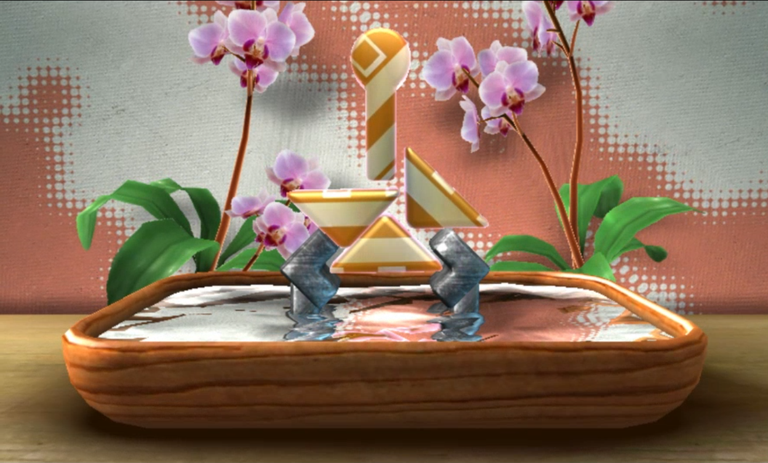

Surprise surprise!
I had thought myself that I would have ran out of super specific digital-only handheld releases that I only remember because I ran into them years ago...but then this one came to mind from back then where I had played the free demo there was for this game.
Art of Balance: TOUCH is a small but inventive game that would feel very natural in smartphones nowadays, which is interesting to think when I don't know if there have been games that have replied this exact premise - but even more surprisingly, found out after talking with someone else that this game was actually available in Wii, Wii U, PS4 and Switch- the 3DS version being the first port after the Wii version.
The developer, Shinen, definitely has quite a few higlights in other genres, such as the Nanostray games for DS as well as the futuristic racing FAST series featured in the Wii [FAST Racing League], Wii U [FAST Racing NEO] and Switch [FAST RMX] which have been brought up at the time as the stand ins for the absence of official F-Zero games.
But this one is certainly a game that isn't something you will hear most talking about due to how it isn't this...high octane arcade game or big budget console game, but rather something that was tailor made as a WiiWare game [a small game that fits as a digital purchase and uses the Wiimote] and happened to get brought over to the 3DS making use of the touch scren.
Which is why, of course, I show up here today to talk about it. Although it is understandably more recognizable than 10 Second Run and even the Nintendo-made PiCTOBiTS due to its availability in PS4 and Switch [even if it is unfortunate it isn't officially available on PC].
A sleek look and sound
If there's something that can connect the developer of this with the FAST racing games [even if it is quite a stretch], its in the surprisingly sleek presentation it has.
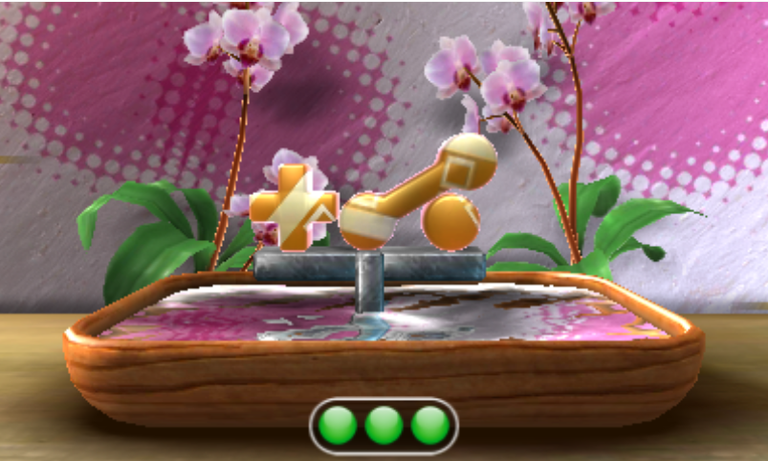
You aren't really placing abstract figures on an abstract plane, but placing these shapes in this bowl of water with stone platforms for you to place the shapes. The visual detail of this for a puzzle game alone I would consider a very nice addition that flows with the theme of the gameplay itself [balance].
The music is also as chill as possible to go with the visual ambience, sounding like stuff you could hear in a very stylish hotel lounge, although it has a few unique tunes used for when you enter certain challenge stages. This is doubly complemented by the clacking sounds for picking up shapes and placing them, as well as the countdown sound being so satisfying to hear when you can heard the third big chime signifying your victory.
And speaking of the countdown...
Building a steady stack, even if for a moment
The goal is simple: Put all the shapes you have in hand in a way that they can stay balanced, so that they can last the 1-2-3 it takes for the game to actually clear the level.
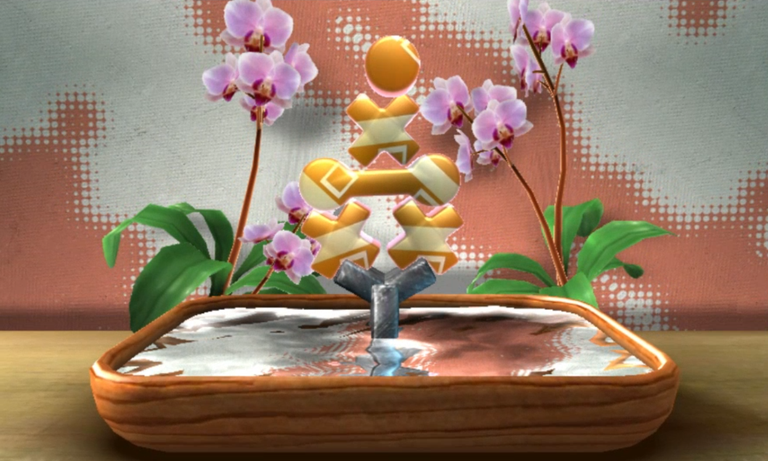
For most of the stages you can find at the start, this will just take some playing around the logic of what shapes could hold up others or in what ways they could stand on top of each other without pushing the rest. As it should be, the first challenges are as simple as thinking the right order to place all the things so that there's no wobbling to worry about.
Now, that 1-2-3 countdown actually means one thing: If the stack you build with all the pieces is slowing down and can see its going to fall off, what separates that from being a close victory to a blatant defeat is if the countdown ends before any pieces touch the water.
So you can end up with screenshots like this: The very obviously falling tower that counted as a win because the countdown ended before they got wet.
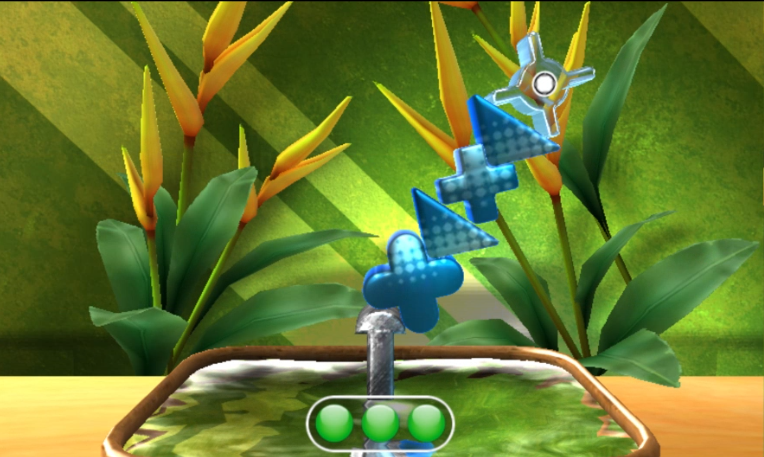
Note that something I saw when watching footage of the WiiWare version is that the countdown lasts a notch longer than the countdown in this version, so chances are that you won't be able to get away with stuff like this if you are playing the original instead of this version.
Throwing some gimmicks into the mix
The first foundation to solid puzzle games is that you can make more creative challenges with just the basics you give, as some levels will force you to think, rethink and get inventive with how to put all the places that seem to be unfitting between each other at first.
But then it does what a solid puzzle game should also do and adds a few extra ways to change the dynamic.
In all worlds, there are challenges that go about stacking a specific height with all the pieces, stacking all the pieces before a timer runs out, or levels that force you to play with a specific kind of platform, such as a block floating over water or a wide platform over a small stick that forces you to be mindful of the weight placed on it.
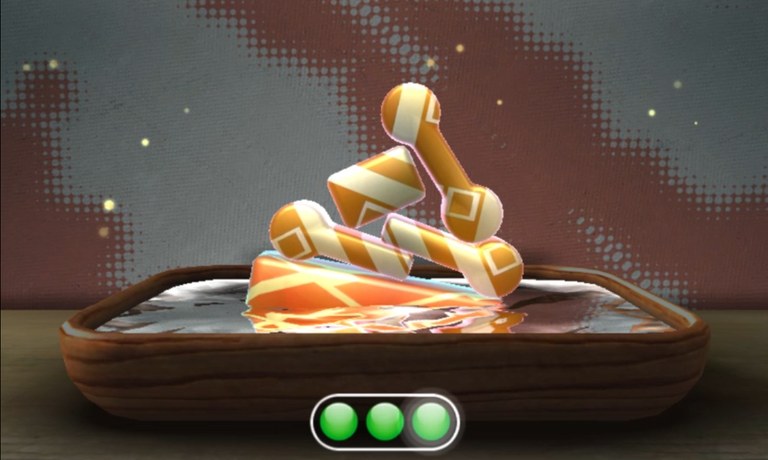

Those challenges are found in orange colored levels, which grant two points instead of one from the common gray levels, although that doesn't mean that some gray levels won't force you to think solutions - just that those specifically don't use those challenge gimmicks.
...But that is not to say that later worlds don't add unique gimmicks either.
World 2 adds these glass shapes that will break once three pieces are put on top of one, so you have to work around with where to place them so that they can work as pieces without breaking.
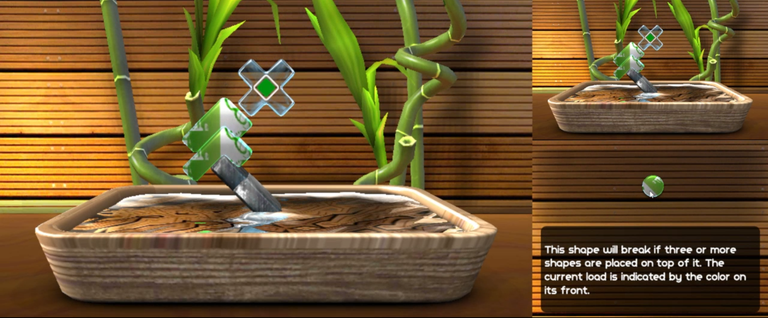
World 3 then adds timed glass shapes that will break in a second as soon as a piece is placed on top of it, so those will also make you rethink on how to work around those, either by figuring out ways to place them last so that they don't have to be broken, or think on placing a piece above one in a way that they land safely on a solid piece below it once it breaks.
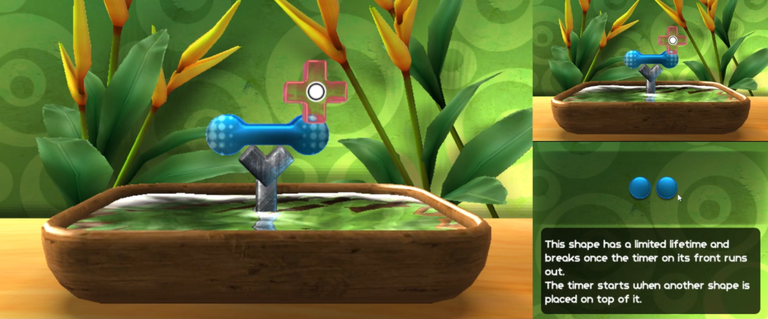
I have already heard both from someone else and from reviews of the game that where things get truly nefarious is when the second half of the game kicks in, which I have yet to reach.
Conclusion
This game has more cloth to cut through another day, as I can totally believe a difficulty spike being arond the corner. So whenever I can put my hands into this game and keep diving until I unlock those later levels, I will probably come back to talk about whatever insanity awaits me with those, considering that each world adds a new gimmick and this is a game about balancing shapes, so there will likely be many things forcing you to think out of the box.
But if you want to see how I fared there so far, with some levels cleared fast from being pretty easy to visualize as a stack with the right pieces, while others that took me a while to either stay balanced for enough time...I did get to record my playthrough.
In one specific case, I was using a totally wrong approach for a minute or so until I though on changing where I placed the shapes and suddenly it made sense 😅
Thanks for reading!

Spanish translation with DeepL. All screenshots were captured by myself.
Español
¡¡¡Sorpresa sorpresa!!!
Yo mismo había pensado que se me habrían acabado los juegos superespecíficos de portátiles en formato digital que sólo recuerdo porque me los encontré hace años... pero entonces me ha venido a la cabeza este de entonces en el que había jugado a la demo gratuita que había de este juego.
Art of Balance: TOUCH es un juego pequeño pero ingenioso que se sentiría muy natural en los teléfonos inteligentes de hoy en día, lo cual es interesante pensar cuando no sé si ha habido juegos que han replicado esta premisa exacta - pero aún más sorprendente, descubierto después de hablar con otra persona que este juego en realidad estaba disponible en Wii, Wii U, PS4 y Switch- la versión de 3DS siendo el primer port después de la versión de Wii.
El desarrollador, Shinen, ha destacado en otros géneros, como los juegos de Nanostray para DS y la serie de juegos de carreras futuristas FAST para Wii [FAST Racing League], Wii U [FAST Racing NEO] y Switch [FAST RMX], que en su momento se mencionaron como alternativa a la ausencia de juegos oficiales de F-Zero.
Pero este es un juego del que no oirás hablar a la mayoría debido a que no es un juego arcade de alto octanaje o un juego de consola de gran presupuesto, sino más bien algo que se hizo a medida como un juego de WiiWare [un pequeño juego que se puede comprar digitalmente y que utiliza el Wiimote] y que se llevó a la 3DS haciendo uso de la pantalla táctil.
Y por supuesto, ese es el motivo por el cual estoy aquí para hablarles de este. Aunque es comprensiblemente más reconocible que 10 Second Run e incluso que el PiCTOBiTS de Nintendo debido a su disponibilidad en PS4 y Switch [aunque es una pena que no esté disponible oficialmente en PC].
Un aspecto y un sonido elegantes
Si hay algo que pueda relacionar al desarrollador de este con los juegos de carreras FAST [aunque sea bastante exagerado], es en la presentación sorprendentemente elegante que tiene.

En realidad no estás colocando figuras abstractas en un plano abstracto, sino colocando estas formas en este cuenco de agua con plataformas de piedra para que coloques las formas. El detalle visual de esto para un juego de rompecabezas por sí solo lo consideraría una adición muy agradable que fluye con el tema del juego en sí [equilibrio].
La música también es lo más relajada posible para acompañar el ambiente visual, como la que se podría escuchar en el salón de un hotel con mucho estilo, aunque tiene algunas melodías exclusivas que se usan cuando entras en ciertas fases de desafío. Esto se complementa doblemente con los sonidos de chasquido al recoger las formas y colocarlas, así como con el sonido de la cuenta atrás, tan satisfactorio de escuchar cuando se oye la tercera gran campanada que significa tu victoria.
Y hablando de la cuenta atrás...
Construir una pila estable, aunque sea por un momento
El objetivo es sencillo: Coloca todas las figuras que tengas a mano de forma que puedan mantenerse equilibradas, para que aguanten el 1-2-3 que necesita el juego para superar realmente el nivel.

Para la mayoría de las fases que puedes encontrar al principio, esto sólo requerirá jugar un poco con la lógica de qué formas podrían sostener a otras o de qué manera podrían colocarse unas encima de otras sin empujar al resto. Como debe ser, los primeros retos son tan sencillos como pensar el orden correcto para colocar todas las cosas de forma que no haya que preocuparse por el tambaleo.
Ahora bien, esa cuenta atrás 1-2-3 en realidad significa una cosa: Si la pila que construyes con todas las piezas se está ralentizando y puedes ver que se va a caer, lo que separa eso de ser una victoria ajustada a una derrota flagrante es si la cuenta atrás termina antes de que ninguna pieza toque el agua.
Así que puedes acabar con capturas de pantalla como esta: La torre muy obviamente cayendo que contó como victoria porque la cuenta atrás terminó antes de que se mojaran.

Ten en cuenta que algo que he visto al ver imágenes de la versión de WiiWare es que la cuenta atrás dura un un tanto más que la de esta versión, así que lo más probable es que no puedas salirte con la tuya con cosas como esta si juegas al original en lugar de a esta versión.
Mezclando algunos trucos
El primer fundamento de los juegos de puzles sólidos es que puedes hacer retos más creativos con sólo lo básico que das, ya que algunos niveles te obligarán a pensar, repensar y ponerte ingenioso con cómo colocar todos los lugares que al principio parecen no encajar entre sí.
Pero luego hace lo que también debería hacer un juego de puzles sólido y añade algunas formas extra de cambiar la dinámica.
En todos los mundos, hay retos que consisten en apilar una altura específica con todas las piezas, apilar todas las piezas antes de que se agote un temporizador, o niveles que te obligan a jugar con un tipo específico de plataforma, como un bloque flotando sobre el agua o una plataforma ancha sobre un palo pequeño que te obliga a estar atento al peso que se coloca sobre ella.


Esos desafíos se encuentran en los niveles de color naranja, que otorgan dos puntos en lugar de uno de los niveles grises comunes, aunque eso no significa que algunos niveles grises no te obliguen a pensar soluciones, sólo que esos específicamente no usan esos trucos de desafío.
...Pero eso no quiere decir que los mundos posteriores no añadan trucos únicos.
El Mundo 2 añade estas formas de cristal que se rompen cuando se ponen tres piezas encima de una, así que tienes que pensar dónde colocarlas para que funcionen como piezas sin romperse.

El Mundo 3 añade formas de cristal temporizadas que se romperán en un segundo en cuanto se coloque una pieza encima, así que también tendrás que replantearte cómo hacerlas funcionar, ya sea encontrando la forma de colocarlas en último lugar para que no tengan que romperse, o pensando en colocar una pieza encima de otra de forma que aterricen de forma segura en una pieza sólida debajo de ella una vez que se rompa.

Ya he oído, tanto por otra persona como por las críticas del juego, que donde las cosas se ponen verdaderamente nefastas es cuando entra en acción la segunda mitad del juego, a la que aún no he llegado.
Conclusión
Este juego tiene más tela que cortar un día más, ya que puedo creer totalmente que un pico de dificultad está a la vuelta de la esquina. Así que siempre que pueda meterle mano a este juego y seguir buceando hasta desbloquear esos niveles posteriores, probablemente volveré para hablar de cualquier locura que me espere con ellos, teniendo en cuenta que cada mundo añade un nuevo truco y que este es un juego sobre equilibrar formas, así que es probable que haya muchas cosas que te obliguen a pensar fuera de la caja.
Pero si queréis ver cómo me ha ido hasta ahora, con algunos niveles que se han superado rápido por ser bastante fáciles de visualizar como una pila con las piezas adecuadas, mientras que otros me han llevado un buen rato o bien mantener el equilibrio durante el tiempo suficiente... he podido grabar mi playthrough.
En un caso específico, yo estaba usando un enfoque totalmente equivocado durante un minuto o así hasta que pensé en cambiar donde coloqué las formas y de repente tuvo sentido 😅
¡Gracias por leer!

Traducción al español hecha con DeepL. Todas las fotos capturadas por mí.
This looks like a fun game. It’s impressive how it started as a simple WiiWare game and gradually made its way to other platforms.
Going from Wii to 3DS and even Wii U is one thing (with how there were many 3DS to Wii U ports and vice versa), but I was definitely not expecting to find out it was on the PS4 and Switch too - making this a game that's actually more accessible than I first thought.
But yeah, it is pretty fun so far.
Thanks for reading and for your comment :)
You're most welcome 🤗 Keep it up.